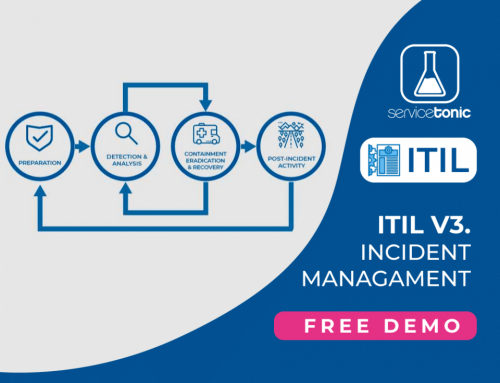Table of Contents
Basic recommendations to implement Service Management based on ITIL.
If you have followed us through the previous 8 posts on ITIL, you should have a good understanding about the best practices proposed by ITIL and its benefits. The next step is the key:
How to implement ITIL in my organization?
Here are some ideas on how to approach an implementation of ITIL and what main factors we should consider.
The implementation of ITIL as an improvement process
When an organization decides to implement ITIL it does not start from zero. It is probably already providing some IT Service and very possibly it is already operating in some aspects as described by ITIL.
Thus, the implementation of ITIL could be seen as a process of continuous improvement.
Where do we start to improve? Let us not forget that the main objective and the reason of Service Management as a discipline is to bring value to the business. Therefore, we should start with those aspects that are having a major negative impact on the business.
For example, if our users complain that the response times in resolving incidents are causing low staff productivity perhaps a good idea would be to start by formalizing the Incident Management process.
Short-term vs. long-term
A good way to start is by evaluating the current IT Service. We can do it with a SWOT analysis (strengths, weaknesses, opportunities and threats) which would give us a global view of our situation in order to establish a program of improvements.
Each proposed improvement returns benefits on different time scales. For example, creating a service desk that gives service to users and registers all requests for monitoring will bring visible benefits quickly. However, implementation of problem management may take longer.
It is very important that our improvement program is balanced between short–term and long–term benefits because although we have to make improvements that will lead us to achieve our strategic goals, we must also implement improvements to report immediate benefits so that all parties begin to look favorably on the ITIL implementation project. Quick wins for your ITSM implementations team is important.
ITIL implementation affects people
ITIL implementation is not only to design processes, establish policies and implement tools. In fact, this is the easy part. The change will surely affect the way people work and/or are organized, and the hardest part is probably getting people’s involvement in the project in a positive way.
In this aspect, it can be very useful to understand the emotional cycle associated with the change (shock, denial, blaming others, blaming oneself, acceptance and optimal execution) and techniques such as the 8-step process by Kotter to lead change.
5 tips when implementing ITIL
At least the following aspects are needed to properly manage ITIL implementation:
– Support from business management in the ITIL implementation project.
– Be clear with and communicate why change is needed. People accept change better if they understand why it is done.
– Communicate clearly the future situation that we want to reach and our objectives. A vision that guides us will avoid confusion during the project.
– A plan. Without a plan, the implementation would be chaos.
– Sufficient human and economic resources. For example, resources for training, for a service management tool etc.
Common errors in ITIL implementation
Some factors that may adversely affect the success of an ITIL implementation project are:
Not having the support from business management
The ITIL implementation can be complex and costly so it is essential to have the full support of the leadership of the organization.
The ITIL implementation is an IT project
If only IT staff participate in the designing the ITIL processes, then the whole project will have an IT only perspective. This can call for a rejection from the people that are supposed to benefit. The reason being, users in the business were unable to share their vision as they were not involved in the project.
Lack of balance between strategic efforts and short-term benefits
Defining an ITIL implementation project from which we will begin to reap the benefits in 1/2/3 years is a mistake. It is quite possible that our project, formulated in this way, is abandoned in favor of other projects with a shorter ROI.
As mentioned above, it is very important that our improvement program has a balance between short-term and long-term benefits.
Excessive level of detail in the process
An excessive level of detail in all processes of solution can lead us to:
– Having complexities in the management of the implemented solution.
– Excessive cost when making changes.
– High risk of failure.
– Failure to comply with the required information for being too complex/expensive.
We should:
Apply the 80/20 principle. With 20% of the cost eventually cover 80% of the needs.
– Whenever possible, reuse what already exists in the organization, do not design new items unless it is absolutely necessary. Do not reinvent the wheel.
Addressing the project with unqualified personnel
Sometimes ITIL implementation projects are addressed without qualified ITIL personnel. It is recommended that those who play a role in the process undertake a training in ITIL according to their role.
Put an end date to the ITIL implementation project
If we approach the ITIL implementation project as a project with an end date, it could happen that:
– You forget one of the main stages of the service lifecycle: continuous improvement.
– The involved personnel, after a while, goes back to what they did before the project implementation.
In order to avoid this, consider the ITIL implementation as an ongoing program.
Addressing the project without an adequate tool
To help automate all tasks and information flows associated with the provision of a service, we need to have a tool that captures the designed solution and evolves to the new requirements emerging in the process of continuous improvement.
Without a proper tool, it is practically impossible, for reasons of efficiency, to manage services as proposed by ITIL. – Manuel Molero, CTO ServiceTonic



